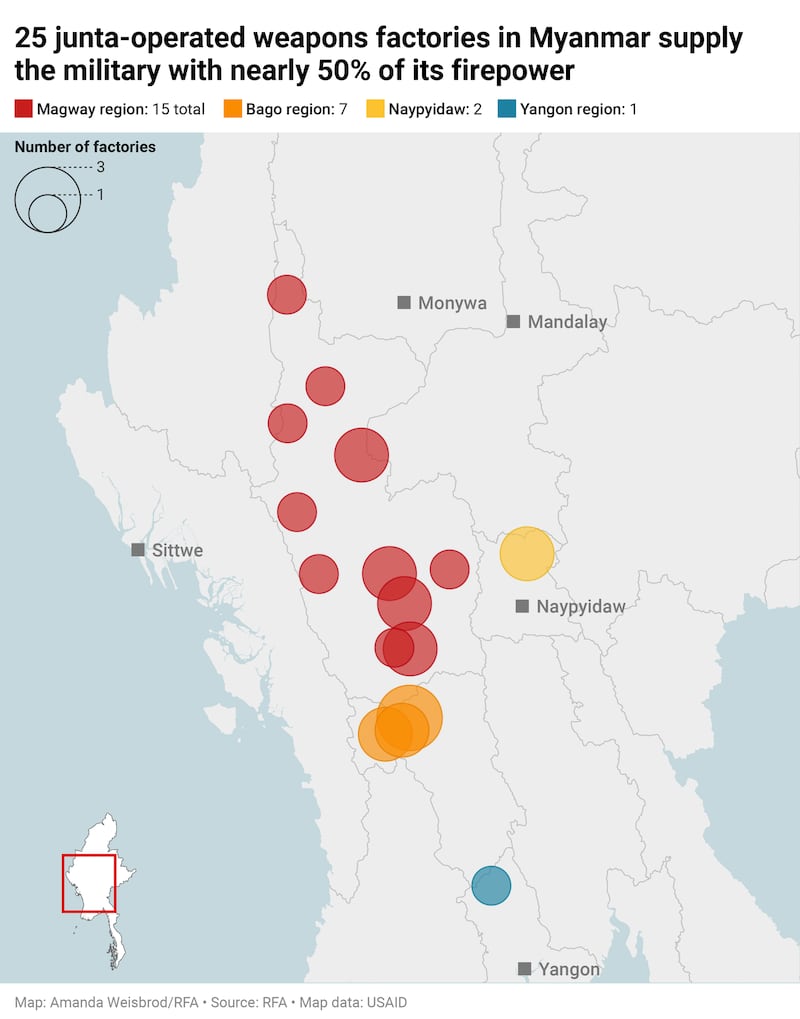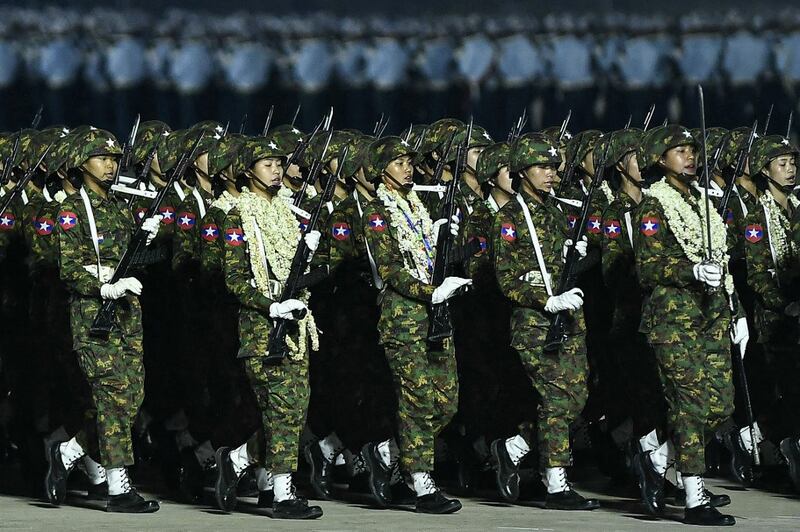[ Read RFA coverage of this story in Burmese. Opens in new window ]
Nearly two dozen weapons factories are keeping Myanmar’s junta in the business of war, providing around half of the munitions the military regime has used in a years-long conflict against its own people, defectors said.
Most of the munitions used by the junta are made domestically. But it has obtained weapon manufacturing technologies from China and North Korea, and is approaching Russia to acquire new capabilities, said former Capt. Zin Yaw, who defected to the rebel side and now advises the Civil Disobedience Movement, or CDM, of public servants who resigned after the 2021 coup d'etat.
The military has long exerted influence over Myanmar, and has taken steps to ensure that it doesn’t lose that control, even in times when it does not rule outright. When the military’s influence wanes, it uses violence to achieve its goals, most recently in the February 2021 coup and subsequent bloody crackdown on dissent.
While public backlash to that seizure of power has rarely been as intense as during the last four years, the country’s armed opposition remains at a significant disadvantage due to the junta’s vast military complex.
Former military officials recently told RFA Burmese that the junta operates 25 defense industries plants – collectively known in Burmese by the acronym “Ka Pa Sa” – throughout the country, including 15 in Magway region, seven in Bago region, one in Yangon region, and two in the capital Naypyidaw.

Of the 25, around 20 are responsible for maintaining the junta’s grasp on power, according to former Capt. Zin Yaw, who is now serving as an adviser to the Civil Disobedience Movement, or CDM, of public servants that resigned in the wake of the 2021 coup.
“The junta is surviving due to these ‘Ka Pa Sa,’ which are supplying the military with up to 50% of its firepower,” he said.
Many who served in manufacturing roles at the plants are now fighting as part of the anti-junta People’s Defense Forces, or PDFs, formed by civilians after the putsch to protect their communities from the military, he added.
Naung Yoe, a former sergeant in the junta’s air force who defected to the CDM, told RFA that the Ka Pa Sa are even producing rudimentary munitions for military drones.
"We have some reports from military personnel in service that the junta is using PVC pipes filled with gunpowder in manufacturing drones, possibly due to a shortage of components,” he said.
RELATED STORIES
[ Junta military preparations point to brutal next phase in Myanmar conflictOpens in new window ]
[ Airstrike targets insurgent meeting in Myanmar, 16 killedOpens in new window ]
[ Myanmar military adds advanced Chinese drones to arsenalOpens in new window ]
[ Rebel drones target junta powerbase in Myanmar’s capital, shadow govt saysOpens in new window ]
Naung Yoe said that while he was serving in the air force he personally transported bullets and 110-kilogram (250-pound) aerial bombs produced by Ka Pa Sa No. 3 in Bago region’s Pyay township, as well as 110- and 225-kilogram (250- and 500-pound) bombs built at Ka Pa Sa No. 21 in Magway region’s Seikphyu township.
He also witnessed the trial production of surface-to-air missiles known as Rockets 18 and 57 at one of the plants, he added.

Other former military sources told RFA that the various Ka Pa Sa produce “MA” model rifles, ammunition of various calibers, artillery shells, bombs, grenades, mines, gunpowder and components for various weapons.
Arsenal largely homegrown
The junta is using locally-made arms and ammunition from these factories to fight its battles in the country’s remote ethnic border areas, said Colonel Naw Bu, the spokesperson of the Kachin Independence Army.
“The junta is relying on arms and ammunition … produced at its defense industries plants,” he said. “While there are some weapons supplied by foreign countries, its arsenal is largely produced at the Ka Pa Sa for the ongoing civil war."
But a spokesperson for the Seikphyu township branch of the anti-junta People’s Defense Force, which was formed by civilians to protect their communities from the military, told RFA that production at the Ka Pa Sa has declined amid increased attacks by the armed opposition.
“Troops from our forces have regularly conducted offensives [against the factories], firing with heavy weapons and drones,” said the source, who spoke to RFA on condition of anonymity due to security concerns.
Attempts by RFA to contact Myo Myint, the junta’s spokesperson and social affairs minister for Magway region, for comment on the military’s weapons production capabilities went unanswered by the time of publishing.
According to a January 2023 report by the Special Advisory Council for Myanmar, composed of former high-ranking United Nations officials, more than 45 companies from 13 countries, including Israel, have provided Myanmar’s junta with military technology and raw materials for producing weapons.
The report also advised that U.N. member states should block aid to the junta, targeting defense factory officials and arms brokers, in order to protect the people of Myanmar.
Translated by Aung Naing. Edited by Joshua Lipes and Malcolm Foster.

